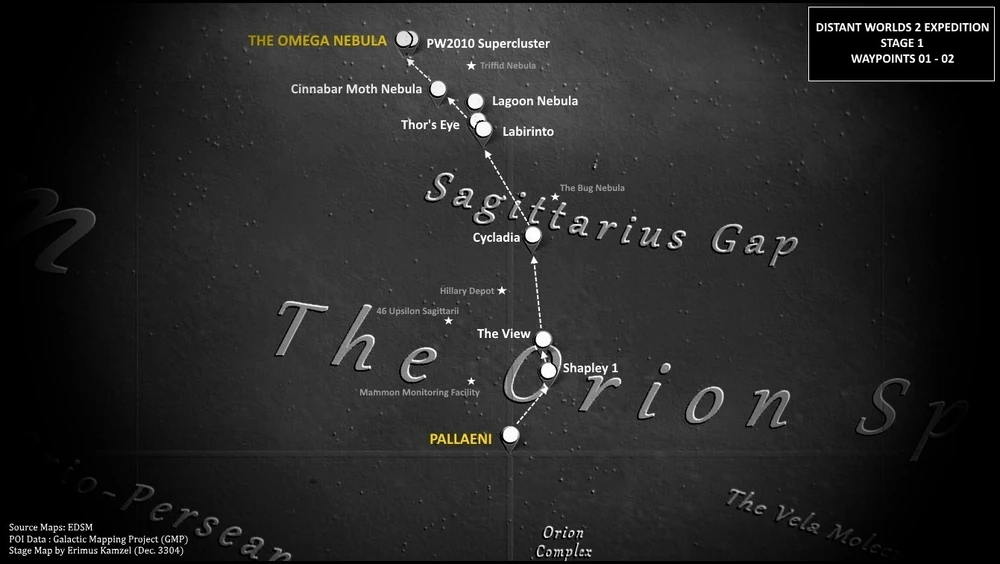
PW2010 210 (113.68LY)
The PW2010 Supercluster
The PW2010 Supercluster (NGC 6618) is a cluster of young stars of stellar types B and A, lying in the vicinity of the Omega Nebula, from which it evolved a mere million years ago. The cluster holds more than 800 solar masses and is responsible for burning away a good portion of the surrounding gas. Several black holes and neutron stars can be found as binaries, bearing witness to the violent nature of the cluster’s birth.
Traikaae KT-P d6-10 (1,217.96LY)
Cinnabar Moth Nebula
A red and black Nebula resembling a moth or butterfly from certain angles.
Herschel 36 (1,124.23LY)
Good view of the Lagoon Nebula
A distinctive green and orange nebula situated on the near rim of the Norma arm, approx. 4,500 LYs from Sol in the constellation Sagittarius. It is one of only two star-forming nebulae faintly visible to the naked eye from mid-northern latitudes on Earth.
Herschel 36 is the primary star of the Lagoon Nebula. This hot O-type star emanates ultraviolet light, heating and ionizing gases on the surface of the nebula.
Due to its convenient location just on the other side of the Sagittarius-Gap, the Lagoon Nebula has been used as a waypoint for many explorers travelling towards the galactic core regions.
Thor’s Eye (270.99LY)
Thor’s Eye
Thor’s Eye is the name given to this system containing a massive O-class star and a black hole. Some cartographers consider it to have been misnamed – the Norse God who lost an eye was Odin (not Thor).
Thor’s Eye is a common waypoint for travelers heading to the Lagoon Nebula, which is just 250 LY toward galactic north. Thor’s Eye is situated in the middle of open cluster NGC 6530, composed mainly of class-A and class-B stars and various stellar remnants (neutron stars and black holes). A blue-white supergiant can also be found nearby (HD 164865).
Traikaae CH-Y c10 (148.67LY)
Body: 1 A
Labirinto
Surface Features – South Pole (-60, 20 area).
Commentary from the pilot who discovered this POI (CMDR Akira Masakari):
“In the Colonia Route, between Hillary Depot and Amundsen Terminal, I’ve discovered and untagged system with few Gas Giants. I proceeded to scan the only Water Life bearing world I detected with sounds, and its moons. To my surprise the first moon showed a very rugged surface, especially in the south polar regions. I proceeded to orbital cruise and I was amazed: canyons with vertical walls several kms deep formed an incredibly intricate maze that confluxed into a huge impact crater, several hundred kms wide, surrounded by 12 vertical walls. If this wasn’t enough, the planet is dotted with vertical spikes that emerge from the valleys for many kms, being visible on orbit protruding from the horizon of the planet.
Another distinguishing feature is that the planet has very wide cracks, and at the bottoms they are covered with forests of hundred meters high rock spikes, making this areas completely unlandable.”
Blu Thua GI-B b55-2 (1,573.43LY)
Ringed ELW Cycladia
A visually spectacular earthlike world with a double ring system. From certain angles and distances, the inner rings appear to be orbiting so fast that it is visible to the naked eye.
HR 6164 (1,402.19LY)
The View Tourist Beacon
At only 1400 light-years from Sol, HR 6164 is a popular destination for tourists. The bright O-class star, a neutron star, and two black holes are easily visible from the first planet; along with a excellent view of the planet’s rings. The location has simply been labelled ‘The View’, and a beacon has been established here by Universal Cartographics. Additionally a tourist installation has been installed just outside the jet-cone of the neutron star and provides breathtaking views of this phenomena.
Pilots should be aware of the dangers in visiting. The planet’s gravity is 3.30g which may be a surprise for novices. The tourist installation is located extremely close to the neutron star jet-cone; falling into this cone in normal space will cause extreme damage to your vessel. Approach should be made with great caution.
Shapley 1 (431.61LY)
Best viewed from Fine Ring Sector JH-V c2-4.
The Fine Ring Nebula (also known as Shapley 1), is a planetary nebula with a unique ring structure. Unlike most planetary nebula, the Fine Ring Nebula is non-bipolar and torus-shaped with a distinct blue colour.
As most nebula of this type are caused by the expulsion of the outer layers of the host star, the shape may indicate that the Wolf-Rayet class host star had a particularly violent expulsion event at a period of high rotational velocity.
Historical note : Shapley 1 was the first waypoint system of the Distant Worlds 3302 expedition.
Waypoint 1: Pallaeni (831.96LY)
Original Arrival Date: 13/1/3305
Body: A
Distant Worlds Expedition 3302 Tourist Beacon
On January 13th 3305, the Distant Worlds 2 Expedition launched from the tourist beacon in Pallanei dedicated to DW1.
This time the fleet heading out into the black was estimated to be in excess of 13,500 ships, making it by far that largest concentration of Commanders in one location at any one time to this point in history of the game.
The start was spread in to three events for Europe, USA and Australia. Three different time zones so people could attend. Europe was the first one at 20:00 UTC on January 13, 3305.
This first starting jump from Pallaeni was the cause of a massive server outage as thousands of Commanders all hit jump at once. Oopsie! Not the first time Distant Worlds has done this, but the biggest one so far! FDev’s community manager Paige took to socials to assure everyone the team was working to bring the galaxy back up again.
Polygon wrote a great article on the event: https://www.polygon.com/features/2019/1/14/18182085/elite-dangerous-distant-worlds-2-launch-server-crash/
And with that, we’re back at home!

